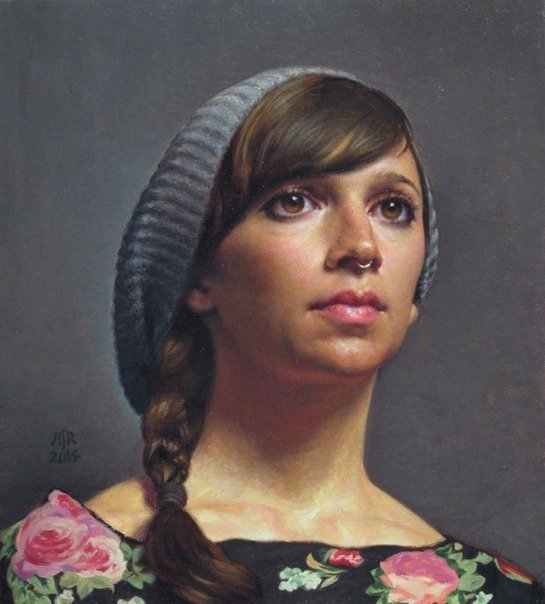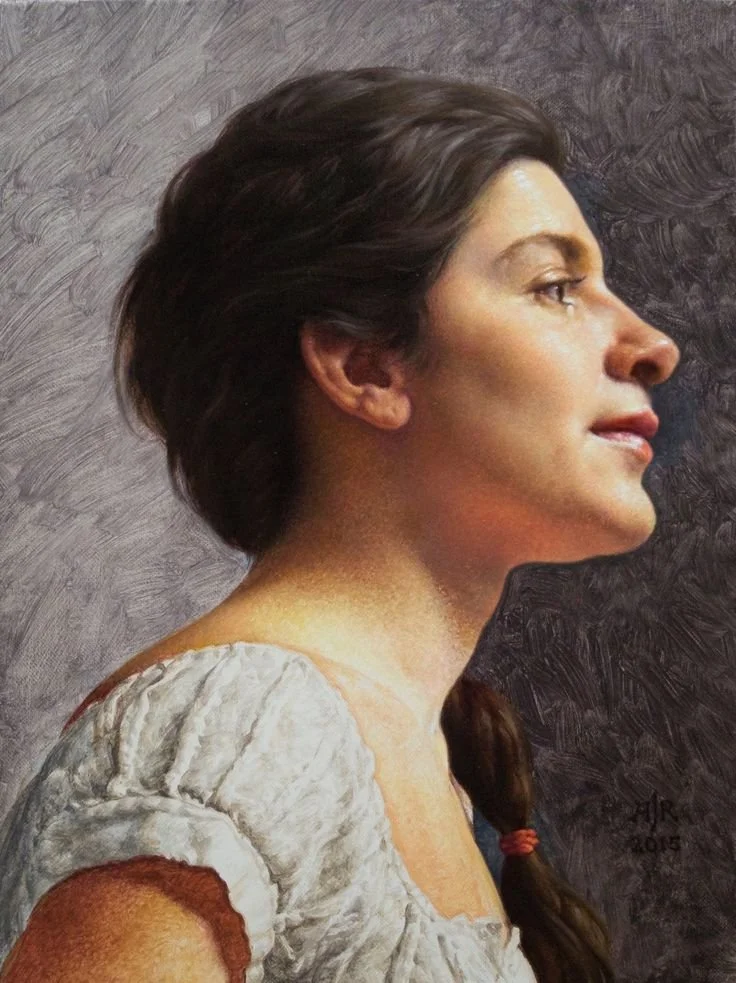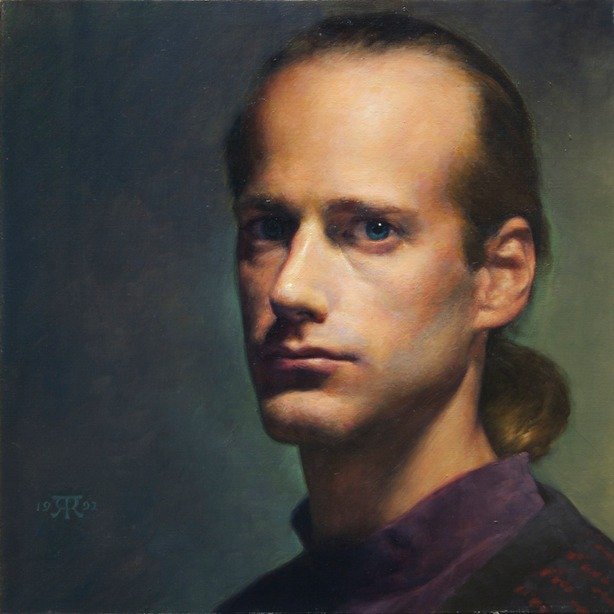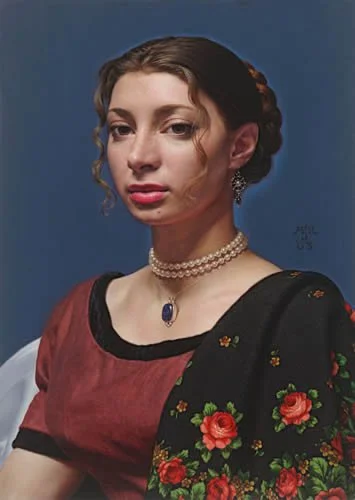
Tony Ryder Master Residency Portrait Painting
Sign up for both drawing and painting workshops, receive a discount.
A very rare opportunity to study portrait painting with Tony
Enrollment now open.
This workshop was quite popular please enroll to hold your spot.
Dates: August 21-25, 2023
Dates: August 28- September 01, 2023
(In the BACAA Studio from the live model) 10 Days
Hours: 11:00-5:15 p.m.
Lunch: 1:30 p.m -2:15 p.m.
BACAA Tony Ryder 2022 Registration
Portrait Painting in Oil
An Introduction to Form Painting, a Complete Method of Painting the Portrait in Oil, in Five Stages
The Five Stages of Form Painting
Poster Study
The poster study is the first exercise in the form painting process. It is a postcard-sized, simplified, abstract color sketch that represents the major tonal elements and tonal relationships of the composition. The world that we see, which is the light that enters our eyes, consists of many-colored beams of light, related to one another in a delicately balanced harmony. We call this tonal balance of the reality of the model in the space, the ‘Poster’, and we see it in terms of hue, value and chromatic intensity. We build the poster study from dark to light, ignoring details. The poster study is the foundational exercise in Form Painting in seeing and mixing color.
Charcoal Drawing and Ink-In
We carry out the remaining stages of the form painting process directly on the panel that is to be the support of the finished painting. The second and third stages are the Charcoal Drawing and the Ink-In.
The drawing is done in vine charcoal. As a precursor to oil painting, because it’s easily removed, vine is a variety of charcoal that lends itself to drawing on canvas and panel. Once the drawing is finished, its lines are inked in with a fine small brush, using a dilute mixture of oil paint and solvent. This ‘ink’ drawing dries to the touch by the following day, and the charcoal is brushed away.
Wash-In
The fourth stage is called the Wash-In. The wash-in is a thin under-painting executed in dilute washes of oil paint and solvent. It somewhat resembles a watercolor. Unlike monochromatic under-painting techniques, the wash-in is fully chromatic.
The wash-in is an intermediate layer. It is the mediating factor that unites and reconciles the bare canvas and the finished paint surface.
The wash-in helps solve many of the problems that we would otherwise encounter if we were to paint a finished painting directly on white canvas. One such problem has to do with knowing whether or not the colors we’re applying to the painting are indeed the ones we want. Colors, by themselves, are never right or wrong. They can only be judged in their tonal context, i.e., in the painting itself. That context is never fully realized until the painting is done. Consequently, while the painting is in progress there is always a degree of uncertainty involved in the choice of colors. However, we can take steps to lessen the degree of uncertainty.
We already took one such step when we painted the poster study. In that exercise we began to acquaint ourselves with an accurate estimation of the tonal structure of the composition. The wash-in is another step in this direction. In it we gradually build up, through a series of quick drying layers, a thin under-painting that approximates a true painted version of the scene we intend to paint.
Against a white background nearly all colors seem very dark, and many of them seem much less intense than they would in the context of a finished painting. The tendency when painting on a white surface, is to make everything too light and too saturated. It is difficult to judge colors accurately. It is much easier to judge the colors of the final paint layer when they’re applied on top of the wash-in.
Another difficulty arises when we attempt to achieve certain color effects with only a single paint layer. Many tube colors are either transparent or semi-transparent. Consequently, many of the color mixtures we produce on our palettes are likewise somewhat transparent. It is difficult to cover the white of the canvas uniformly with such mixtures. The application of these colors over a white surface results in a mottled, uneven paint layer. In order to cover the white surface uniformly, such paint must be thickly built up. This makes it difficult to handle. By contrast, thin paint films are relatively easy to handle, and are preferable to thick paint films, especially when painting delicate passages in which intricate drawing and subtle shading play a part. The wash-in pre-tints each part of the canvas with a color foundation similar to the final color mixture to be applied in that place at a later time. Much of the work of covering the canvas is thus accomplished in the wash-in. It therefore enables us to paint relatively thinly in the final coat.
The wash-in is the dress rehearsal of the finished painting. It prepares the canvas (and the painter) for the exacting effort of finding and applying the precise color mixtures of the form painting process.
Form Painting
The fifth and final stage gives its name to the entire process: Form Painting. It is a ‘direct’, ‘window shade’ method of painting ‘wet into wet’, and ‘into a dark base’. In form painting we mix individual colors with a brush on the palette, and apply them to the surface of the canvas, brush stroke by brush stroke, creating continuous, changing tonal progressions. These progressions mimic the changes of light and shade that we see on the model. Since the colors are applied directly, and opaquely, rather than being developed indirectly by the multiple transparent layers typical of glazing techniques, form painting is considered to be a ‘direct’ painting method.
This is not a ‘paint everywhere quickly’ approach. Instead, form painting is a ‘window shade’ technique. We paint one section at a time, finishing it completely, before we go to the next, adjacent section. The painting slowly reveals itself as if a window shade were being withdrawn to expose the scene hidden behind it. This approach necessitates careful control of value and color. It benefits from an accurate drawing.
We begin painting each section in the darker tonalities, at the bottom of the tonal progression, and then proceed up into the light, for which reason this method is referred to as painting ‘from dark to light’. Furthermore, we paint each section in two layers: an initial, somewhat generalized, and slightly darker layer, called the ‘dark base’, then, while the base is still wet, we brush in the ‘lights’. Thus, we paint ‘wet into wet’ and ‘into a dark base’.
Cost: $1590 (10 Days)
Discount if you sign up for both Drawing & Painting ($2950)
BACAA Tony Ryder 2022 Registration
All tuition fees are non refundable and non transferable
Registration form/Terms and conditions must be completed and agreed to, or signed prior and emailed prior to attendance
Pay by Cashiers Check, Bank Bill Pay, Zelle®, Credit Card, or PayPal
We do not accept Personal Checks.
We do not accept cash.
Partial Payments are not accepted.
Pay by Zelle® at info@bacaa.org
Pay now via PayPal or credit card
Portrait Painting
Combined Drawing and Painting
Partial Payments are not accepted.
We do not accept cash.
All tuition is non-refundable and non-transferable.
Please send checks and packets to the BACAA BUSINESS ADDRESS:
969G Edgewater Blvd, 106
Foster City, CA 94404
~~~~~~~~~~~~~~
BACAA STUDIO ADDRESS
345 Quarry Rd
San Carlos, CA 94070
Contact: info@bacaa.org
650-832-1544

View fullsize

View fullsize

View fullsize

View fullsize

View fullsize

View fullsize

View fullsize
